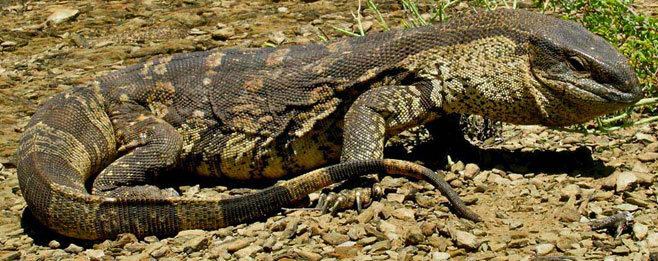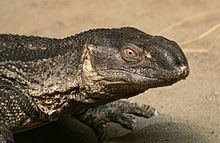Genus Varanus Scientific name Varanus albigularis Rank Species | Phylum Chordata Family Varanidae Subgenus Polydaedalus Higher classification Monitor lizard | |
 | ||
Lower classifications Black‑throated monitor, White‑throated monitor | ||
The rock monitor (Varanus albigularis), also called the legavaan or white-throated monitor, is a species of monitor lizard found in Central, East and southern Africa. It is the second-longest lizard found on the continent, and the heaviest bodied.
Contents

Taxonomy

First described by François Marie Daudin in 1802, these lizards were previously classified as a subspecies of Varanus exanthematicus, but have since been declared a distinct species based upon differences in hemipenal morphology. The generic name Varanus is derived from the Arabic word waral ورل, which is translated to English as "monitor". Their specific name comes from a compound of two Latin words: albus meaning "white" and gula meaning "throat".
The subspecies of V. albigularis are:

Description

This is the heaviest-bodied lizard in Africa, as adult males average about 6 to 8 kg (13 to 18 lb) and females weigh from 3.2 to 5 kg (7.1 to 11.0 lb). Large mature males can attain 15 to 17 kg (33 to 37 lb). It is the second longest African lizard after the Nile monitor, Varanus albigularis reaches 2 meters (6 ft 7 in) in length, with its tail and body being of equal size. Mature specimens more typically will measure 0.85 to 1.5 meters (2 ft 9 in to 4 ft 11 in). The head and neck are the same length, and are distinct from each other. Their bulbous, convex snouts give an angular, box-like appearance. Their forked tongues are pink or bluish, and their scales are usually a mottled gray-brown with yellowish or white markings.
Intelligence

An intelligent lizard, several specimens have demonstrated the ability to count as high as six in an experiment conducted by Dr. John Philips at the San Diego Zoo in 1999. Philips offered varying numbers of snails, and the monitors were able to distinguish numbers whenever one was missing.
Distribution
This monitor ranges in these areas: Central Africa (Democratic Republic of the Congo/Zaire), Southern Africa (Namibia, Botswana, Republic of South Africa, Swaziland, Zimbabwe, Mozambique, Zambia, Angola), the African Great Lakes (Kenya, Uganda, Tanzania), and the Horn of Africa (Ethiopia, Somalia). It is found in a variety of dry habitats, including steppes, prairies, and savannahs, but is absent from desert interiors, rainforests, and thick scrub forests.
Folklore
People living with the HIV/AIDS virus in Yumbe district of Uganda have been injecting themselves with the blood of rock monitors, which they believe to be a cure for the virus. Most are discontinuing anti-retroviral therapy to pursue this anecdotal treatment. As a result, V. albigularis is reported to have become an expensive item in the Ugandan black market, selling for more than US$175 each.
